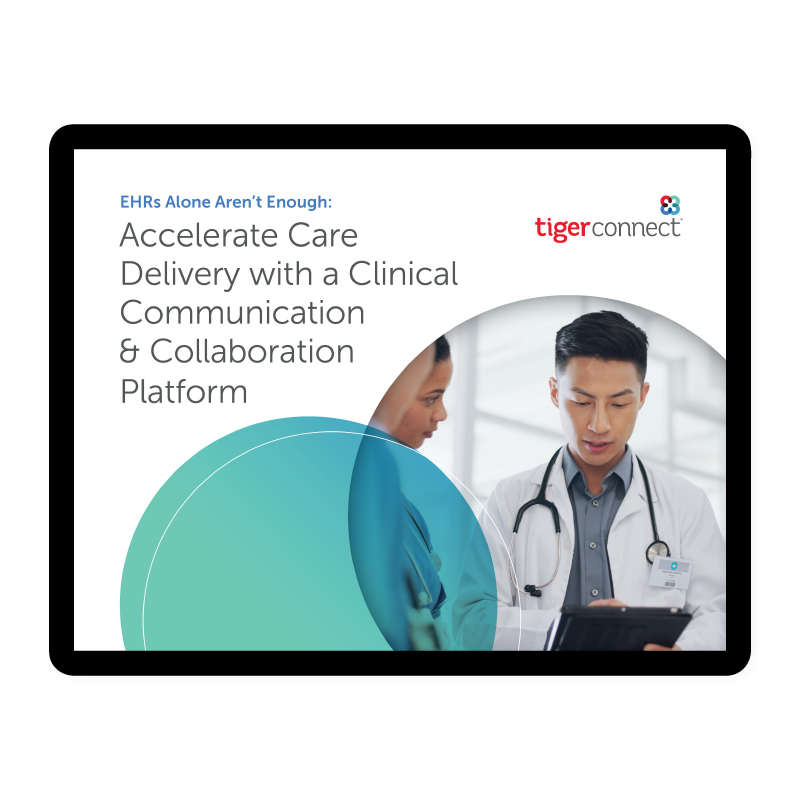Home / Blog /
Don’t Be Fooled by the EHR Chat: The Need for a Comprehensive Clinical Collaboration Platform

Don't Be Fooled by the EHR Chat: The Need for a Comprehensive Clinical Collaboration Platform
When it comes to healthcare IT, the allure of immediate cost savings can sometimes lead organizations down a path fraught with challenges. Electronic Health Record (EHR) systems that offer built-in chat tools appear to be a straightforward way to streamline communication, right? After all, it simplifies vendor management and often comes at no extra cost. But before jumping in, there’s a crucial pitfall you must avoid: mistaking an EHR chat tool for a comprehensive clinical communication & collaboration platform.
EHRs Alone Aren’t Enough
|
 |
The enduring drawbacks of EHR chat
Equating EHR chat with a comprehensive clinical communication and collaboration (CC&C) platform leads to an “accidental architecture,” where the organization ends up with a fragmented system incapable of meeting the diverse needs of clinical teams. For example, the siloed nature of EHRs often hinders information flow, creating communication barriers across departments and institutions. Initially designed for documentation, they aren’t naturally equipped for seamless data exchange. This is where CC&C platforms become crucial.
While EHR chat tools may appear to offer convenient communication, the long-term repercussions can be significant. Here are some of the enduring drawbacks associated with prioritizing quick cost savings over long-term efficiency:
- Escalating clinician burnout: Clinical staff already face significant challenges, and technology should aim to alleviate those challenges rather than exacerbate their burden. EHR chat is not advised for urgent communication, so clinicians often must turn to other communication methods to convey critical information. This friction in communication causes care team frustration due to the inability to locate the right provider, leading to higher rates of clinician burnout.
- Sluggish digital evolution: While EHRs have made strides in digitizing healthcare records, they often fail to facilitate efficient data retrieval and comprehensive clinical collaboration. Advanced clinical communication and collaboration platforms break down information silos by integrating with EHRs and other clinical systems to intelligently route contextual notifications and alerts to the right person at the right time. Acting as a central hub between clinical systems, advanced CC&C platforms drive digital evolution beyond the limitations of the EHR alone.
- EHR downtime: While EHRs offer benefits in storing patient data, their downtime poses significant challenges in fast-paced hospital environments. Any period of EHR downtime, whether complete or partial, can be disastrous, hindering day-to-day operations and putting patients and staff at risk. Healthcare organizations must adopt reliable and interconnected communication systems to mitigate the negative impacts of EHR downtime.
- Limited access for non-clinical staff: Communication across departments and facilities can prove challenging when non-clinical staff need EHR access or encounter restricted permissions. For example, when transferring patients out of the hospital to another facility, the clinician may rely on contacting ancillary staff to coordinate the information. Slow communication during this process greatly affects the time to transfer, impacting both hospital costs and patient satisfaction.
EHR messaging is not meant to handle urgent communication that requires quick response times. CC&C platforms, however, go beyond simple messaging, integrating perfectly with existing systems like scheduling and alarm management platforms. Rather than relying on disjointed internal communication methods, integrating EHRs with a CC&C platform can fill communication gaps and speed care decisions in various clinical settings. Implementing these solutions unlocks the true potential of EHRs, boosting internal workflows and opening up broader access to patient data within the care continuum. Ultimately, breaking down these data silos empowers care teams to deliver better care.
Here’s why dedicated CC&C platforms stand out:
- Intuitive experience: Forget clunky interfaces. CC&C platforms work like your personal messaging app, making them instantly familiar and easy to use for everyone on the care team.
- Flexibility: Adapt to any situation. CC&C platforms aren’t one-size-fits-all. They can be adapted to your specific needs, whether it’s secure text messaging, role-based teams, or real-time updates.
- Efficiency: Time is precious. CC&C platforms eliminate communication silos and delays by integrating seamlessly with your existing systems, streamlining workflows, and boosting productivity.
Long-term efficiency with TigerConnect
Effective healthcare communication requires a proactive strategy to implement scalable, highly integrated collaboration platforms that drive diverse outcomes. Instead of yielding to the appeal of immediate cost savings, organizations should prioritize long-term efficiency and clinical effectiveness.
The TigerConnect Clinical Collaboration Platform seamlessly connects with various clinical systems, from EHRs and nurse call solutions to smart beds and real-time location systems. This eliminates constant, irrelevant alarms for nurses, empowering them to focus on delivering attentive patient care instead of managing disruptions. It’s a win-win for both efficiency and patient experience.
Ultimately, EHRs were not designed for communication — healthcare organizations need a dedicated communication solution. By implementing a CC&C platform, you can unlock the true potential of streamlined communication in healthcare. Remember, it’s not just about convenience; it’s about empowering better care coordination, collaboration, and, ultimately, better patient outcomes.
Ready to learn more? Schedule a demo to discover how a dedicated platform can help transform communication at your healthcare organization.
Timothy Beglin, Clinical Nursing Consultant
Tim Beglin has been involved with nursing informatics for over 14 years, dedicated to improve clinical workflows for nurses, providers, and other healthcare professionals. He has been an Epic builder, Epic clinical site lead, IT Relationship Manager and has led a team of other nursing informaticists. Tim has abundant experience navigating the complexities of clinical organizations and healthcare technology in order to achieve sustainable process improvement.
Tags: cons of EHR chat, downsides of EHR chat, EHR chat, Blog, EHR messaging, Clinical Collaboration Platform, Healthcare IT, Clinical Communication








